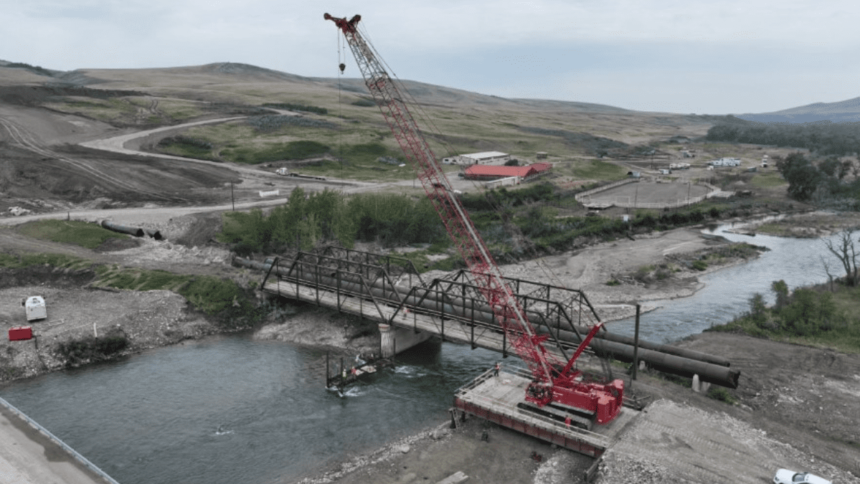In some areas, the Milk River has dried up. Locals indicate that the 350-mile backbone of the Hi-Line is functioning as expected without the large amount of water that used to be delivered by the now broken St. Mary Siphon pipeline.
The economic impacts of two full growing seasons without normal irrigation are already being felt.
“We were only able to irrigate 50% of our acres for the second time this year, so we have already seen a decrease in productivity,” said Marko Manoukian, a farmer near Malta and co-chair of the working group assigned to rehabilitate the halted irrigation system.
When the 8-foot pipes supplying water to the Milk River burst in June, Manoukian knew that dry riverbeds were in the future for the 18,000 Montana residents who rely on the Milk River for water. Long-time residents mention that the Milk River would run dry six out of seven years without the help of the St. Mary siphon.
The siphon is a large-scale project from the early 1900s. Through a diversion dam and several miles of pipes and chutes, the project diverts St. Mary River water heading towards Canada near Babb into the Milk River, which then supplies water for drinking and irrigation all the way to Glasgow, 353 miles to the east on U.S. Highway 2.
Also reduced to a trickle is a promised $275 million from Congress for repairs. Congressional staff members indicate that it’s unlikely for a bill to pass until after the general election. Both House and Senate bills require attention, and there are limited workdays before the election. The House is in session for 13 days, while the Senate is in session for 15 days over the same period.
There is also political maneuvering to prevent opponents from scoring wins before the election, according to anonymous congressional staff members. In the Senate, the passage of a repair funding bill introduced by incumbent Montana Democrat Jon Tester could make a significant difference in determining the party that controls the chamber. Similar situations exist in the House, where Montana’s Republican U.S. Representatives Matt Rosendale and Ryan Zinke have introduced competing bills to allocate the funding.
Rosendale, who is not running for reelection in Montana’s eastern district, has a bill that mirrors the one introduced by Tester in the Senate. This alignment between the bills eliminates delays usually caused by reconciling different versions in separate chambers.
Zinke’s bill, however, differs from Tester’s Senate version as it includes $250 million for a Blackfeet Reservation wastewater treatment plant that is not present in the Senate bill. If both bills pass, they will need to be reconciled in a conference committee where differences are resolved.
Funding for the irrigation project repair, including the siphon, is part of the Fort Belknap Water Compact and Settlement bill, which Tester ushered through the Senate in June. The compact is a $1.3 billion legislation settling water rights claims of the Gros Ventre and Assiniboine tribes of the Fort Belknap Reservation.
This week, construction begins on the planned replacement of the St. Mary diversion dam, for which $100 million has already been committed.
Additionally, the Milk River Joint Board of Control is finalizing arrangements with the state of Montana for $26 million in funding from the Department of Natural Resources and Conservation. The irrigators will need to repay interest on the loan under terms set by the Montana Legislature, but they are not required to repay the principal.
RELATED

Why it takes a crisis to trigger funding for Montana’s largest irrigation project
The rivets were still popping from the seams of the St. Mary siphon when Jennifer Patrick started crunching the numbers for repairing the century-old system that 18,000 residents of Montana’s Hi-Line depend on for water. It would take 3,600 feet of pipe so big men can walk through it without bumping their heads. They would need a new steel bridge across the St. Mary River and enough earth-moving equipment to restore a river channel completely buried beneath rocky soil eroded from the hillside where the siphon blew. They were short of one thing money couldn’t buy: time.
Project Manager Jennifer Patrick said the work with the state is progressing. Currently, the funding for repairs is expected to be fully utilized by Nov. 1. Damaged pipes have already been removed from the siphon area by construction crews. New steel pipes, originally expected by the end of the year, are now anticipated to arrive in late September or October from Northwest Pipe in Oregon, according to Patrick.
Officials cautiously predict that the irrigation system will remain offline until late summer or early fall of 2025, resulting in another growing season without irrigation. Communities along the Milk River will need to rely on water stored in reservoirs or water towers until the Milk River flows again and local reservoirs can be replenished.
The economic challenges facing farmers along the irrigation system are significant, according to economist Joel Shumaker at Montana State University. Farmers who typically harvest two cuttings of irrigated hay, or about 3.5 tons of hay per acre, are likely to only yield one cut next year, similar to this year. Tonnage is expected to decrease by two-thirds as there will be no irrigation for the first and only hay harvest in 2025.
The decrease in hay supply will impact area ranchers who typically purchase regional hay to feed their livestock. The region is still recovering from drought in 2021 and 2022, which forced ranchers to reduce their herds.





